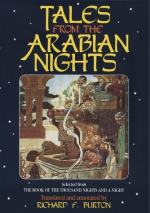[FN#222] Four wives are allowed by Moslem law and for this reason. If you marry one wife she holds herself your equal, answers you and “gives herself airs”; two are always quarrelling and making a hell of the house; three are “no company” and two of them always combine against the nicest to make her hours bitter. Four are company, they can quarrel and “make it up” amongst themselves, and the husband enjoys comparative peace. But the Moslem is bound by his law to deal equally with the four, each must have her dresses her establishment and her night, like her sister wives. The number is taken from the Jews (Arbah Turim Ev. Hazaer, i.) “the wise men have given good advice that a man should not marry more than four wives.” Europeans, knowing that Moslem women are cloistered and appear veiled in public, begin with believing them to be mere articles of luxury, and only after long residence they find out that nowhere has the sex so much real liberty and power as in the Moslem East. They can possess property and will it away without the husband’s leave: they can absent themselves from the house for a month without his having a right to complain; and they assist in all his counsels for the best of reasons: a man can rely only on his wives and children, being surrounded by rivals who hope to rise by his ruin. As regards political matters the Circassian women of Constantinople really rule the Sultanate and there soignez la femme! is the first lesson of getting on in the official world.
[FN#223] This two-bow prayer is common on the bride-night; and at all times when issue is desired.
[FN#224] The older Camaralzaman="Moon of the age.” Kamar is the moon between her third and twenty-sixth day: Hilal during the rest of the month: Badr (plur. Budur whence the name of the Princess) is the full moon.
[FN#225] Arab “Ra’aya” plur. of ’Ra’iyat” our Anglo-Indian Ryot, lit. a liege, a subject; secondarily a peasant, a Fellah.
[FN#226] Another audacious parody of the Moslem “testification” to the one God, and to Mohammed the Apostle.
[FN#227] Showing how long ago forts were armed with metal plates which we have applied to war-ships only of late years.
[FN#228] The comparison is abominably true—in the East.
[FN#229] Two fallen angels who taught men the art of magic. They are mentioned in the Koran (chaps. ii.), and the commentators have extensively embroidered the simple text. Popularly they are supposed to be hanging by their feet in a well in the territory of Babel, hence the frequent allusions to “Babylonian sorcery” in Moslem writings; and those who would study the black art at head-quarters are supposed to go there. They are counterparts of the Egyptian Jamnes and Mambres, the Jannes and Jambres of St. Paul (2 Tim. iii. 8).
[FN#230] An idol or idols of the Arabs (Allat and Ozza) before Mohammed (Koran chaps. ii. 256). Etymologically the word means “error” and the termination is rather Hebraic than Arabic.




